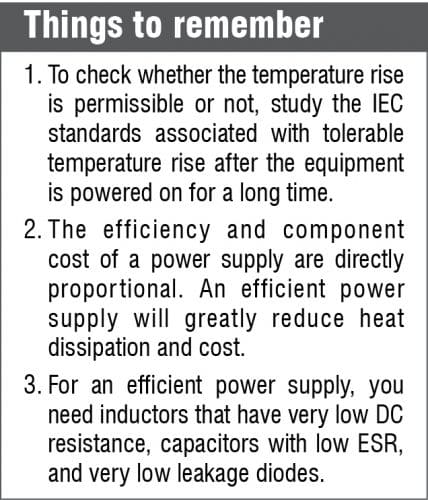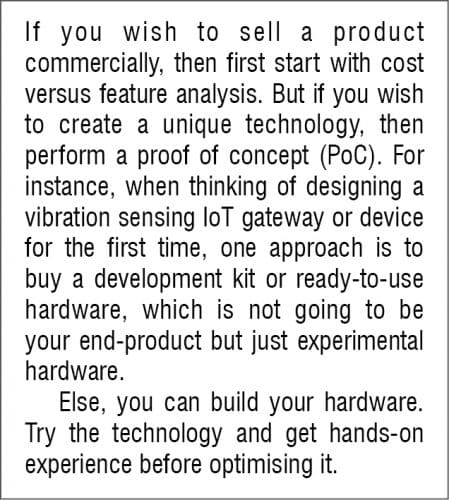Hardware development is more than just PCB design. One has to be mindful of different compliances, optimal power consumption, memory requirements, and other electronics considerations.
Embedded hardware design is no doubt a significant procedure without which embedded devices would cease to exist in everyday life. To quickly meet needs of the growing electronics industry, the developed hardware must be simple, robust enough to withstand harsh tests as well as be reliable for usage in field conditions. Only a carefully planned design can accomplish such challenges.

Basic design requirements
The hardware design includes many activities that begin much before the final hardware design is ready. You initially have to consider the features that the main product is going to have and their cost. Since software cost is non-recurring (one-time cost only), software development expenditure is recovered after several quantities of a product are sold.
It is the hardware that determines the long term final product cost. So you have to be very focused on the cost sensitivity of your design. Thus, it all comes down to cost versus feature analysis. Inexperienced hardware design engineers are very passionate about incorporating all they can into their design within a short time. However, they should refrain from adding more and more features for expandability and be more cost-sensitive.
So, to get a good overview of what all features should be included, first, make a matrix of different features (such as must have, nice to have, and/or optional features) and the cost involved for each. If the cost constraints do not permit you to have any of those features, then make your system modular wherein a basic system meets the primary objectives of the end product. A few add-on modules can provide the rest. Then you can present it and brainstorm with your marketing/production team (for any addition/changes to the final hardware).
Another thing to consider while designing the hardware is the kind of environment in which it will operate. Ask yourself:
- Is it suitable to work at a normal altitude or at an elevated height above sea level?
- What is going to be its operating temperature range?
- Should it be fitted in air-tight or weatherproof enclosures?
- What is going to be the air-circulation or cooling method?
Enclosures are important as they give a first general impression to users regarding a product’s reliability and characteristics such as display and type of user interface. The user interface cannot be overlooked as it plays an important role in overall functioning of the product. UI is the user’s window through which the user accesses your product. Ignoring certain aspects and straightway jumping to hardware design can lead to severe consequences later on.

Whether you plan to sell your product in India or abroad, appropriate standards and certifications are required, such as:
India: Bureau of Indian Standards (BIS)
US or Canada: Underwriters Laboratories (UL) (CSA approval for Canada)
Europe: CE mark or EN standard
In most cases, these standards are very similar. But they should meet specific criteria regarding EMI/EMC requirements and different tolerance levels, etc. So read the applicable standards and then design the hardware.
Besides these, there are several requisite approvals for other countries as well, which must be complied. Else, once your design is ready, it will struggle to pass the safety regulations without appropriate compliances.
These are the basic things one should always begin with.
Now hardware design begins
After recognising all of the above, the initial documentation is prepared as per the design life cycle you are following. Make high-level and low-level design diagrams. List down design constraints, tolerances, and interface diagrams. Then the actual hardware design can begin. Start with the selection of relevant electronic components. Try to have alternate parts for most of the important components with pin compatibility. Check for obsolescence and life expectancy of your product. You also have to write the test cases and define their acceptance criteria. Focus on stating the grounds on which you are going to assume the hardware is perfect. Get it approved from certifying agencies and assure that your test criteria meet the compliances that you are aiming for.
Having done all this, the major challenge is fitting the PCBs into the enclosures. At this stage, several questions arise:
- How will the internal wiring be done?
- Where are the external wires going to or where they come from?
- How is the product going to be installed on the field?
Again, inexperienced engineers tend to forget these things. Because internal wiring may take up a lot of space within the product enclosure, one has to carefully think about how it should be carried out, avoiding the interference.
Things to consider before wiring:
- Size and capacity of the screw terminals
- The current requirement of the screw terminals
- Should it be pluggable?
- D-Sub connectors or pluggable screw terminals for external connection?
After freezing the connector/screw terminal locations, you will get an idea regarding the correct positioning of electronic components on the PCB. It cannot be reversed or other way around. Making space for silicon components/functional boards first and then thinking of how it will be placed into the enclosure may be disastrous. Be careful about the pluggable part of the connector so it does not foul with other parts of hardware, enclosure etc. Such things are often forgotten.

Planning for optimal power consumption
Whether the product/device is battery or mains power operated, ensure to take temperature ranges, heat dissipation and power supply consumption into account.
A microcontroller (MCU) or a microprocessor (MPU) consumes the energy according to its throughput. Power consumption is directly proportional to the controller performance in most cases.
More clock speed equals an execution speed of million instructions per second. Again, in the case of multicore MPU, the power requirement increases as per its cores.
So, calculate how much power it is going to consume and check whether it is permissible or not. Perform heat dissipation analysis of the electronics and analyse how much temperature rise will take place inside the enclosure. This step is very crucial while designing the hardware.
Less power demand and less heat dissipation are the main advantages of an efficient power supply. Heat plays a major role in the longevity of electronic components, particularly capacitors. When exposed to heat, their lifespan starts decreasing.
Memory requirements
After fulfilling the power supply needs, you can go for microcontroller selection. The MIPS rating and power supply consumption are some of the important things that one should track.
Another important thing for microcontroller selection is the memory requirement. The memory contains static RAM (scratch pad memory for software execution) and program memory (flash memory or ROM for storing software programs). So, the question is how much RAM and program memory is adequate?
It is difficult to analyse this question and arrive at an absolute conclusion at the beginning because a software/product regularly undergoes upgradation and customisation whenever new features are demanded by the industry. You also need to keep some space for peripheral obsolescence management. For instance, if the peripheral components like an A-D converter go obsolete, then they will need to be replaced. That may require more software drivers to be added in the future. Additions and changes in communication protocols and standards will require firmware upgrades in future. The new software versions and drivers keep on getting more resource hungry as the memory requirement keeps increasing.
For a typical embedded system not having a heavy-duty operating system like Linux or a simple task scheduler kind of an operating system, you can consider doubling the program memory size than your usual requirement. Also, double the RAM or static memory size as per your requirement. As far as processing speed is concerned, you can consider twice the capacity of your requirement. Any situation can arise later on like fixing a major bug, change in electronics or addition of a feature. Your MPU and memory should be able to accommodate such software changes.
Electronics considerations (analogue and digital)
After selecting the processors, you can then turn to analogue or digital electronics requirements. For this, you may need to use op-amps. Before selecting them, several parameters need to be considered. If your application demands a higher frequency, then choose the ones with better gain bandwidth. If you are amplifying a precision signal from sensors that give a millivolt or microvolt output, then you need precision and low-drift op-amps whose temperature drift is minimal.
Take care of the PCB routing and follow the EMI/EMC guidelines while routing PCBs for all your circuits. If there are analogue circuits, make a board of multiple layers having a dedicated ground layer for better EMI/EMC and ground current handling. Avoid ground current loops on your PCB. With the help of simulation, you can test your analogue electronics first before including it in a circuit diagram for PCB layout.
Takeaway
With plenty of talented engineers graduating in India, the future is bright for start-ups in embedded hardware design. The new generation of designers is getting smarter with the help of a lot of online content available to study.
Indian start-ups should keep the international focus, and not just stick to Indian requirements of quality standards. Go for a product that can be sold outside the Indian market, whether in Europe or America. Or at least aim to be up to that standard.
Do not skip EMI/EMC compliances while making the product and strictly abide by the safety standards, be it in India or abroad.
If the Indian start-ups compromise on quality and make cheap, low-cost products, then there will always be a gap between the Indian and foreign-made products. Indian products should be at par with European and American products.
If you follow the steps and envisage the changes that are going to come along your hardware design journey, then your path is simplified. The flow of hardware design will be smooth if each step is taken care of.
The article is based on the talk ‘Simplifying Embedded Hardware Design’ by Mahendra Karandikar, GM – Developments and Projects at Jay Instruments & Systems, which was presented during January edition of Tech World Congress 2021






